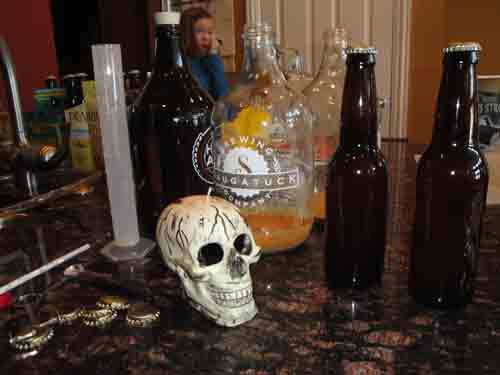It’s a beautiful fall day here in Chicago, though it’s hard to consider 65 degrees as very autumnal. But the harvests are all in, and that has meant it’s time for apple cider.
And while apple cider is nice — one of God’s true gifts to humankind — hard cider can be even better. Or at least it appeals to the part of me that likes gadget and likes to play mad scientist once in a while.

(It’s not that my daughter in the background was scared of my fermenting experiments or the skull candle. She’d just woken up from a well-earned nap.)
Last year I fermented some ciders using a lager yeast, which came out pretty tasty. However, the drafts tasted a lot like those that I made years ago with champagne yeast. They weren’t quite as dry as the champagne batches (which were too dry to even enjoy), but they were very very crisp.
So this year, I made the trip over to “Brew and Grow” to see if they had any yeasts that were specific to making cider. (Cider of course will ferment on its own, if left to its own devices, but it can be a bit of a gamble to end up with a flavor that you like.) And sure enough, amidst all the hydroponic and home gardening equipment for closet-grown “tomatoes”, they sold some yeast specifically made for ciders. The pack was for five gallons of cider, which is about three gallons more than I will drink this winter, so I just estimated the proper amounts. No big deal to put too much in.
I made different batches by using cider from two different farms: Seedlings Orchard, which is run by a friend of mine, and Crane’s Orchard, which is the big chimichanga up by our cottage. The bottles from Seedlings had been pasteurized by ultra-violet light, while Crane’s was just au naturel. (Seedlings is also marketing their own hard cider at liquor stores in the Chicago area, though I haven’t tried it.)
After 10 or so days in the jugs, the bubbling subsided, and I took a measure of specific gravity. Surprisingly, it read that there was NO potential alcohol in either batch. I still haven’t figured that one out — did this yeast not produce any alcohol when it digested the sugars? That seems impossible. Will have to talk with other brewers about this when I think of it. So I siphoned off the liquid into beer bottles and capped them, as shown above, after priming each half-gallon with about a teaspoon of corn sugar. After a week, I brought some to a friend’s house for his birthday.
The results? The cider from Crane’s was clear and crisp, with just the right amount of carbonation. Good adequate drink. But the batch from Seedlings had a lot more complexity, a little peppery bite to the flavor, a touch more carbonation. If forced to choose between the two, I think I’d take Seedlings.
Now I need to find a bottle or two of the commercially made stuff and see if mine is at all similar to it. Seedlings has some “varietal” ciders, with mutsu and jonagold and the like, which they were selling at the farmers markets this fall. To me, those flavors are so delicate that I think fermenting them would almost remove the flavor. For now, I’m going to stick with the generic apple cider, though I do like Seedlings’ combo of cider and cherry juice.
Better living through chemistry.

